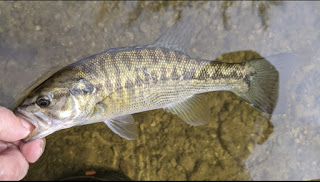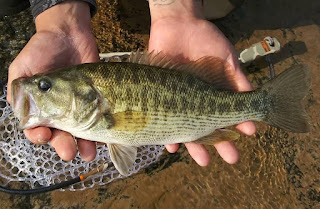The Guadalupe Bass became the State Fish of Texas in 1989, and rightfully so. So without further ado, here is the one I have been waiting to write; here is Texas Freshwater Fly Fishing's Fish Spotlight on our endemic black bass, our Hill Country Emerald (I'm hoping to coin this term), the Guadalupe Bass.
Fish Spotlight: Guadalupe Bass
Appearance
The Guadalupe Bass (Micropterus treculi), is a member of the black bass family along with the better known and more widespread Largemouth Bass, Smallmouth Bass, and Spotted Bass, and has a similar appearance (in body shape and color) to those cousins. Like the largemouth and spotted bass, Guads are typically greenish in coloration. However, the jaw of a Guadalupe Bass is easily distinguished from largemouth bass because the jaw on a Guad does not extend beyond the eye of the fish. To distinguish between a Guad and a spotted bass, you will see that the Guadalupe Bass' coloration extends much lower on it's body. And to separate a Guad from a Smally, the Guadalupe Bass has no vertical bars like you would typically see on a smallmouth bass.
Other distinguishing physical traits of a Guadalupe Bass include a rectangular tooth-patch on the tonged, dark (often almost black) diamond shaped patterns along the sides of the fish, and rows or stripes of spots along a Guadalupe Bass' belly.
 |
| Typical Guadalupe Bass color pattern Photo courtesy James Reese |
Typically around 12 inches in length or so, Guadalupe Bass are smaller than other black basses that are found in the same waters. However, they can grow larger than these 12 inches from time to time. The record Guad (both fly fishing and all-tackle records) currently stands at 3.71 lbs, 17.25" long, and was caught February 1, 2014, by Bryan Townsend in the Colorado River, on a crawfish pattern fly. That is a true Guadzilla. Prior to that (and at the time I wrote "The Plight of the Guadalupe Bass") the record Guad was 3.69 lbs and 18.25 inches long, caught in Lake Travis by Allen Christianson.
 |
| Photo courtesy of Eric Porter |
Diet and Behavior
Guadalupe Bass developed as a species perfectly suited to life in smaller, flowing waters of the rivers and streams in the Texas Hill Country. Because of their life in these smaller flowing waters and their propensity to take a fly, Guadalupe Bass have at times been nicknamed Texas Trout or Green Trout. It has been noted, that larger Guadalupe Bass will often seek slightly deeper and slower waters than the smaller fish. Their diet consists mostly of crayfish, insects and their larvae, and smaller fish found regularly in their native waters.
 |
| Guads are perfectly adapted to life in the gravel bottom rivers of the Texas Hill Country Photo courtesy William Herring |
Typically Guads begin to spawn around early March and finish sometime in May or early June, but there have been some examples of spawning occurring into late fall (possibly a second spawn.) Typically seeking out a shallow, gravel bottom, males will try to choose areas with more current to make their beds than what largemouth bass prefer. Males will choose the location and make the bed before the female comes in to lay her eggs, usually between 400 and 9,000 eggs at a time. The female is then often chased off, and the nest is left guarded by the male Guadalupe Bass.
Distribution
Guadalupe Bass are native only to the northern and eastern portions of the Edwards Plateau (most of what we would call the Texas Hill Country.) Their native ranges include the San Antonio River headwaters, the Guadalupe River system (above Gonzales), the Colorado River system (above Austin), and the Brazos River drainage.
 |
| Photo courtesy Benjamin Felan |
In 1973, before the native range of the Guadalupe Bass was really understood, Texas Parks and Wildlife stocked Guads in the Nueces River system, and have since also been stocked in the lower portions of the Colorado River. These fish stocked into the headwaters of the Nueces River system, and their offspring, have actually come into play in saving the species, by preserving the pure genetics of the Guadalupe Bass.
A Species of Greatest Conservation Need
Guadalupe Bass were first described as a "race of largemouth bass" in the 1870s, and later reclassified as "form of Spotted Bass." It wasn't until the work of Dr. Clark Hubbs of the University of Texas in the 1950s, did the Guadalupe Bass finally get classified as it own true species.
 |
| Photo courtesy of Odom Wu |
This lack of understanding of the Guadalupe Bass has been one of, if not the, biggest threats to its continuance as a species. Hybridization with the Smallmouth Bass since 1974, when Texas Parks and Wildlife began stocking smallmouth in Central Texas in order to "improve the fishing," has had the single greatest negative impact on Guadalupe Bass populations. Rivers like the Blanco River were completely void of any pure strain Guadalupe Bass due to this hybridization with smallmouth bass. These new hybrid Guadalupe x Smallmouth Bass tended to be more aggressive, more fertile, and grow larger, leading some anglers to believe this new fish was "superior" to pure strain Guads, but it also led them to push out and out spawn any pure strain Guads in river systems where Smallmouth were introduced.
Habitat degradation is another continued threat to the existence of Guadalupe Bass. Humans have altered the waters that Guadalupe Bass evolved to live in through the construction of dams (large and small), the development and change of riparian zones, watershed land use, and withdrawal of water (both pumping of in-ground water and water from the rivers) have all negatively impacted the Guadalupe Bass' population. To add on to that, the Texas Hill Country (the Guads home) is one of the fastest growing regions in the United States, with a projected growth of more than 50% (to over 7.3 million people in the area) by 2060. This will add more strain on the very limited water resources and lead to more development along the rivers and streams where the Guadalupe Bass live.
 |
| Photo courtesy Chris Fleury |
All this has led to the Guadalupe Bass being considered "imperiled" and listed as a "Species of Greatest Conservation Need," by Texas Parks and Wildlife. And, if we want to preserve our Hill Country Emerald, all of our efforts are needed.
What is Being Done?
In 1992, Texas Parks and Wildlife started a piolet program to restore the pure strain Guadalupe Bass populations in Johnson Creek (a tributary of the Guadalupe River.) The program was successful enough for TPWD to continue efforts to restore the pure strain Guads to their native waters.
In 2010 the Guadalupe Bass Restoration Initiative was started with funding from the National Fish and Wildlife Foundation. It started by stocking 225,000 pure strain Guadalupe Bass over a five year period to try and outbreed/push out the smallmouth and hybrids. They also began funding projects that would help preserve and protect habitat for all native species in areas where Guadalupe Bass are native.
 |
| Mostly genetic Smallmouth Bass from near the confluence of the San Marcos and Blanco Rivers circa 2009 Photo courtesy of Pat Kellner |
In 2011, a prolonged and dreadful drought (as bad as it was), was a benefit to the restoration of the Guadalupe Bass in the Blanco River where it was once thought to be lost forever. The drought reduced the water in the river to small pools divided by gaps of dry riverbed. These pools concentrated the fish to the point where electroshocking and seining could be done above the area known as "the narrows." In the pools, all the smallmouth bass and other non-native species were removed. When the rains restored the flow of water in 2012, 105,000 Guadalupe Bass were stocked into these waters, with another 122,000 stocked a year later. Tests in 2014 showed success, with upstream from the narrows being 100% pure Guadalupe Bass and downstream even showed 50% Guadalupe Bass. Floods in 2015 could have hurt these efforts (they provided a passage for smallmouth and hybrids to swim upstream), but tests after showed still 100% Guadalupe Bass above the narrows and now 55% downstream from there.
 |
| Photo courtesy of Marco Escamilla |
In 2017, TPWD and the Guadalupe Bass Restoration Initiative partnered with the Southeast Aquatic Resource Partnership, National Fish and Wildlife Foundation, and others, to establish the National Black Bass Initiative. They secured $30 million in funding to help restore endemic basses (including Guadalupe Bass) throughout the United States. They have worked to restore and preserve habitat and stock pure strain Guads along the Llano, Pedernales, and Blanco Rivers. The goal of this program is to maintain 7-10 self-sustaining Guadalupe Bass populations, restore the Guadalupe Bass to numbers great enough to remove them from the Species of Greatest Conservation Needs list, and begin restoring pure-strain Guadalupe Bass to the San Gabriel River as well.
With continued restoration efforts and education, the Guadalupe Bass, our Hill Country Emerald, can continue to thrive and provide great angling opportunities in Central Texas. I know I have a close relationship with the Guadalupe Bass, heck I have even have one tattooed on my leg, and I bet many of y'all reading this do too. Let me know about it!
To read my first Guadalupe Bass article (circa 2012): The Plight of the Guadalupe Bass
Flies for Guadalupe Bass
Other Fish Spotlights
Do you enjoy Texas Freshwater Fly Fishing? If so, you can support TFFF by making purchases at Flydrology.com Your support helps keep Texas Freshwater Fly Fishing up and running, with quality content and a great Facebook group!
Further Reading
American Fisheries Society Symposium: Guadalupe Bass Micropterus treculii (Vaillant & Bocourt, 1874)



Comments
Post a Comment